“Dad, how does the garbage truck eat the trash?”
That’s what my son asked me one morning while we watched one outside. I had no answer.
Even though I work with trucks and heavy machines, I never stopped thinking about how these trucks really worked. So I dug into it—and I learned a lot.
If you’ve ever been curious too, this article will help you. I’ll explain how each part works, how garbage is compacted, and what happens inside that big machine.
By the time you finish, you’ll know exactly how garbage trucks work—and why they matter more than you think.
Let’s dive in!
1. What is a Garbage Truck?
There was a time early in my career, I followed behind a garbage truck and couldn’t help but watch it in action. It stopped, lifted, crunched, and moved on with a rhythm that felt oddly satisfying. And I remember thinking, someone really engineered this process down to the second.
A garbage truck isn’t just a bin on wheels. It’s a purpose-built machine that collects, compacts, and transports waste to landfills, recycling centers, or treatment facilities. It handles an essential job we rarely think about—until trash piles up or smells start spreading.
Here’s what operators typically do:
- Drive a pre-assigned route to collect household, commercial, or industrial waste.
- Load waste manually (common with rear loaders) or control automated arms (used in side and front loaders).
- Monitor truck systems, like hydraulic compactors and safety sensors.
- Follow strict safety rules, especially when working in busy neighborhoods or narrow roads.
- Inspect and maintain the vehicle daily to avoid breakdowns and safety hazards.
Some routes need driver-collectors, while newer side-loaders often allow solo operation with robotic arms—reducing physical strain and staffing needs.
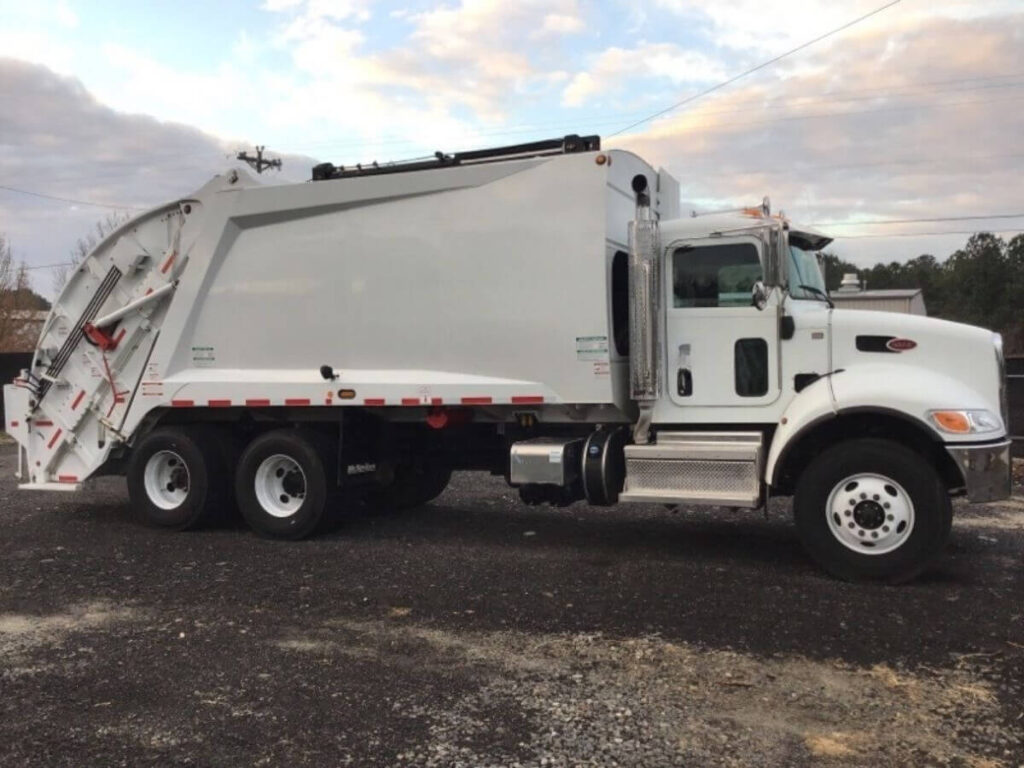
2. How Garbage Truck Works?
I remember the first time I stood next to a garbage truck. It was early morning. The smell hit me first. Then came the sound—a loud hiss, a bang, and the steady hum of the engine.
Garbage trucks might seem simple. But there’s a lot going on under that big metal body. At its core, a garbage truck is a machine that collects, compacts, and transports waste. It helps keep streets clean and cities moving.
Watching a garbage truck work up close gave me a new respect for it. It’s not just about lifting bins. It’s a full process—from pickup to disposal.
So, let’s uncover how garbage truck works in process:
- Step#1 Waste Collection: It all begins with waste collection. The truck drives along a planned route and stops at each bin or dumpster. In some places, the process is manual. Workers grab the bins and roll them to the truck. In other places, it’s automated. A mechanical arm lifts the bin without the driver even leaving the cab.
- Step#2 Hydraulic Lifting: That lifting arm runs on hydraulics. This system uses pressurized fluid to power strong metal arms. They can lift heavy loads fast. It’s smoother than you’d expect. I remember being surprised at how easily it picked up a large bin full of wet trash.
- Step#3 Waste Loading into the Hopper: Once the bin is lifted, the trash gets dumped into the hopper—that’s the open area near the back of the truck. It holds the waste before it’s pushed inside.
- Step#4 Compaction System: Now comes the important part—compaction. A large metal blade moves forward and crushes the trash. This process reduces the size of the waste, making room for more. Less volume means the truck can stay on the road longer before heading to a landfill.
- Step#5 Waste Storage: After compaction, the trash is stored in the main body of the truck. This space is built to hold a lot, even after the trash is crushed. It’s sealed tight to avoid spills and smells.
- Step#6 Waste Ejection: Once the truck reaches the dump site, the ejection system kicks in. The back door opens, and another hydraulic plate pushes all the trash out. It’s fast and powerful—nothing gets left behind.
The next time to watch a garbage truck in action, remember this—it’s not just collecting trash. It’s a step-by-step system that helps keep everything running smoothly.
3. Types of Garbage Trucks
Not all garbage trucks work the same way. Each one is built for specific jobs, waste types, and collection methods. Understanding the differences helps businesses and city services choose the right truck for the task. Whether working in tight neighborhoods or hauling heavy construction debris, there’s a truck made for that need.
Let me walk you through the main types.
Rear Loader Garbage Trucks
These are the trucks most people see in cities and neighborhoods. Workers load trash into the back by hand. Inside, a metal plate called a compactor crushes the waste and pushes it forward to save space. I once helped a friend on his route, and I was shocked how fast the rear loader worked—it didn’t stop once in four blocks.
This type is great for areas where people still leave trash bags on the curb or use small bins.
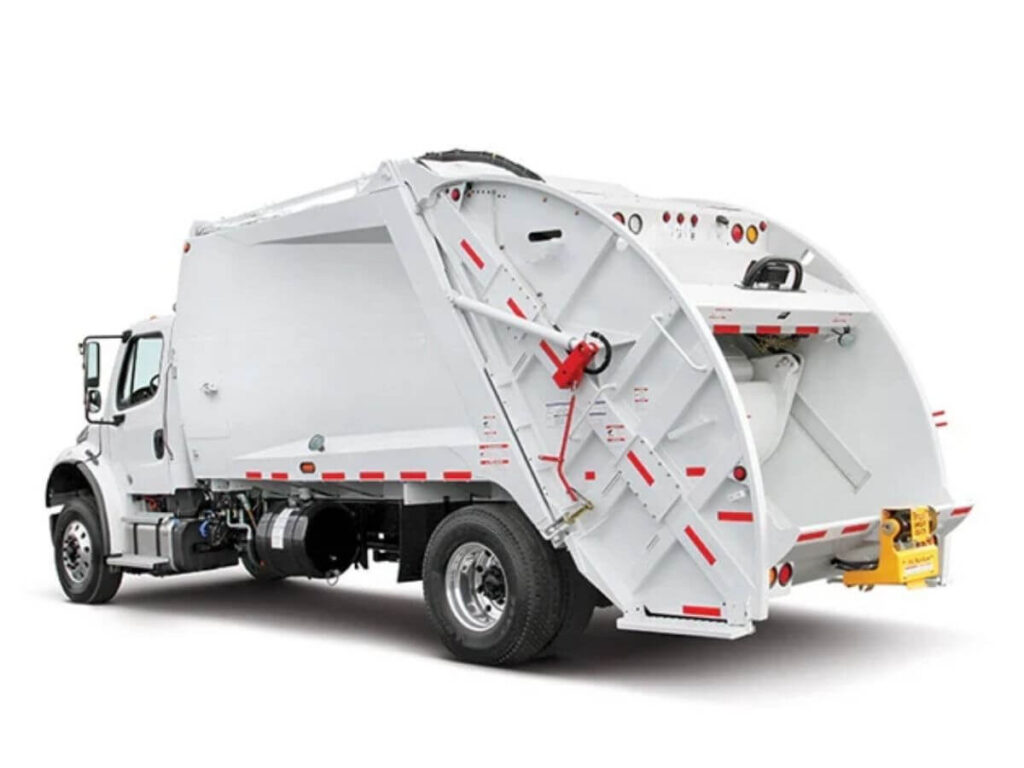
Front Loader Garbage Trucks
These trucks lift large dumpsters using forks in the front. You’ve probably seen them behind shopping centers or warehouses. The forks slide into the slots on a dumpster, lift it up, and dump the trash into a container on top of the truck. The driver handles the whole thing from inside the cab.
They’re ideal for businesses that produce a lot of waste.

Side Loader Garbage Trucks
These trucks are built with an arm on the side. The arm grabs bins, lifts them, and dumps the contents into the truck. Everything is controlled by the driver from inside. That means one person can run the whole route.
They’re commonly used for residential areas and planned communities where bins are spaced out along the street.
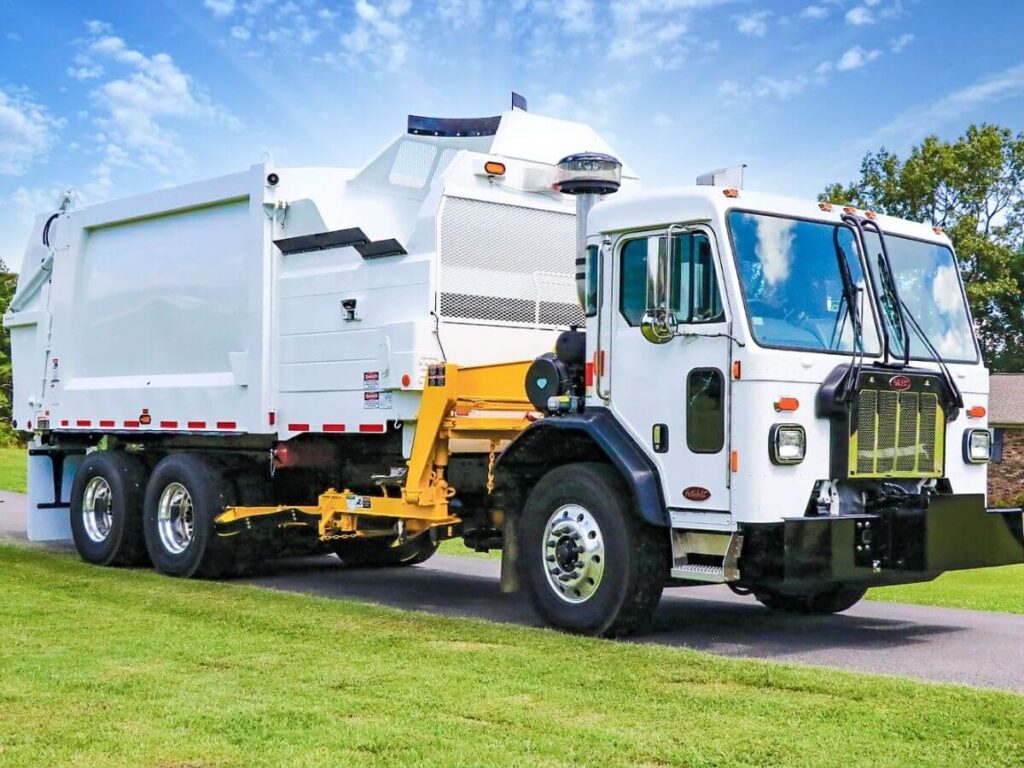
Roll-Off Garbage Trucks
These are the big trucks that deliver and pick up open-top containers. The containers are often used at construction sites, demolition zones, or for large clean-up jobs. The truck rolls the bin off the back, leaves it behind to be filled, and picks it up later using a hook or cable system.
If you’re working with heavy or bulky waste, this is the truck you’ll want.
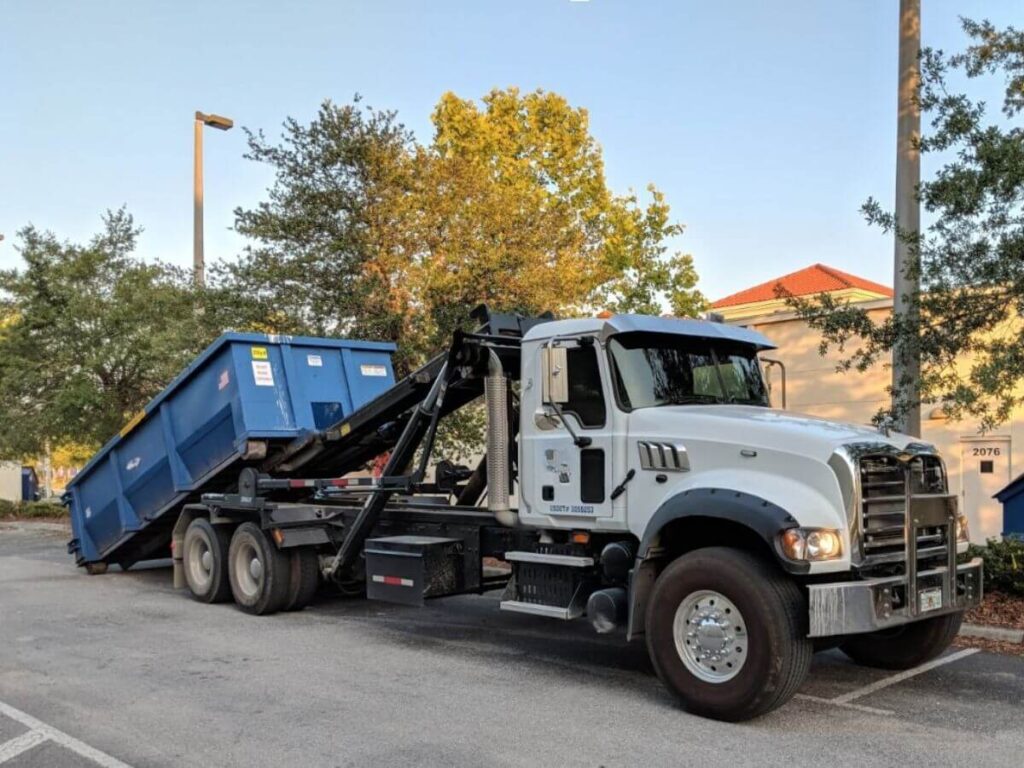
4. Features of Garbage Truck
A garbage truck might look like just a big metal box on wheels—but it’s much more than that. These trucks are full of features that help collect, compact, and haul waste efficiently. Each part is there to make the job safer, faster, and smoother for the people who use them every day.
Hydraulic System
The most important feature is the hydraulic system. It powers the arms, compactors, and ejection plates. This system uses fluid pressure to move heavy parts without much effort. Watching it in action, it’s hard not to be impressed by how smoothly it lifts and compacts trash.
Compactor
Another key feature is the compactor. This is a metal blade that presses the trash tightly into the truck’s body. It saves space and allows the truck to carry more. Fewer trips mean less fuel and lower costs for waste collection teams.
Hopper and Loading Mechanism
The hopper is where trash first enters the truck. It holds the waste before it gets compacted. Some trucks use a rear loading area. Others use a side or front loader. Each design fits a different need.
Ejection System
When it’s time to empty the truck, the ejection system takes over. Most trucks have a hydraulic plate or push-out blade at the rear. The back door opens, and the plate slides forward, pushing all the waste out. It’s fast and clean, with no need to dig or shovel out any leftover trash.
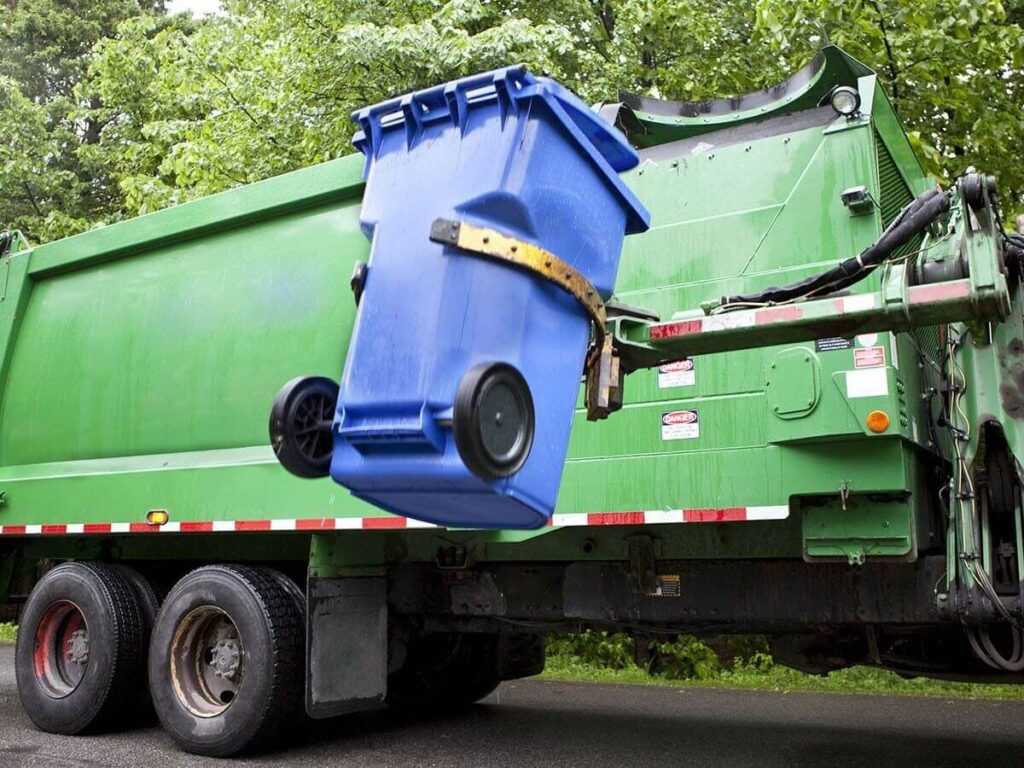
5. Applications of Garbage Trucks
I never realized how many industries rely on garbage trucks until I started working with companies in construction and logistics. What seemed like a simple machine turned out to be part of a much bigger system—one that helps businesses stay clean, safe, and productive.
Let’s look at how different industries use garbage trucks every day.
Construction and Demolition
Construction sites produce a large amount of waste—wood, concrete, steel, drywall, and packaging. If this waste isn’t removed quickly, it can block walkways, delay work, and create hazards.
Garbage trucks help clear the site fast. They collect heavy loads in one trip and reduce downtime. If you’re in this industry and looking to haul more debris efficiently, adding garbage trailers from Rhinotrail is a smart choice. Our trailers are built for heavy-duty use, featuring reinforced steel frames for rough construction waste.
Retail and Warehouse Operations
Retail stores and warehouses generate waste too—broken boxes, shrink wrap, damaged products, and leftover materials. These pile up quickly and take up storage space.
Garbage trucks help maintain a clean, safe back area. This allows workers to keep loading docks open and shelves stocked. In busy seasons, like holidays or sales events, regular pickups make a big difference.
Agriculture and Food Processing
Farmers and food processors deal with a different kind of waste—organic waste. This includes spoiled produce, crop leftovers, packaging waste, and even animal waste.
Letting this kind of trash sit too long can cause strong odors, attract pests, or spread bacteria. Garbage trucks remove it efficiently before it becomes a health risk.
Healthcare Facilities and Public Services
Hospitals, clinics, and schools generate large volumes of trash—medical waste, paper, food wrappers, and more. This waste needs to be collected often and handled carefully.
Garbage trucks keep these public places clean and sanitary. They help protect staff, patients, and students by keeping trash from piling up. In these environments, reliable waste removal isn’t a luxury—it’s a necessity.
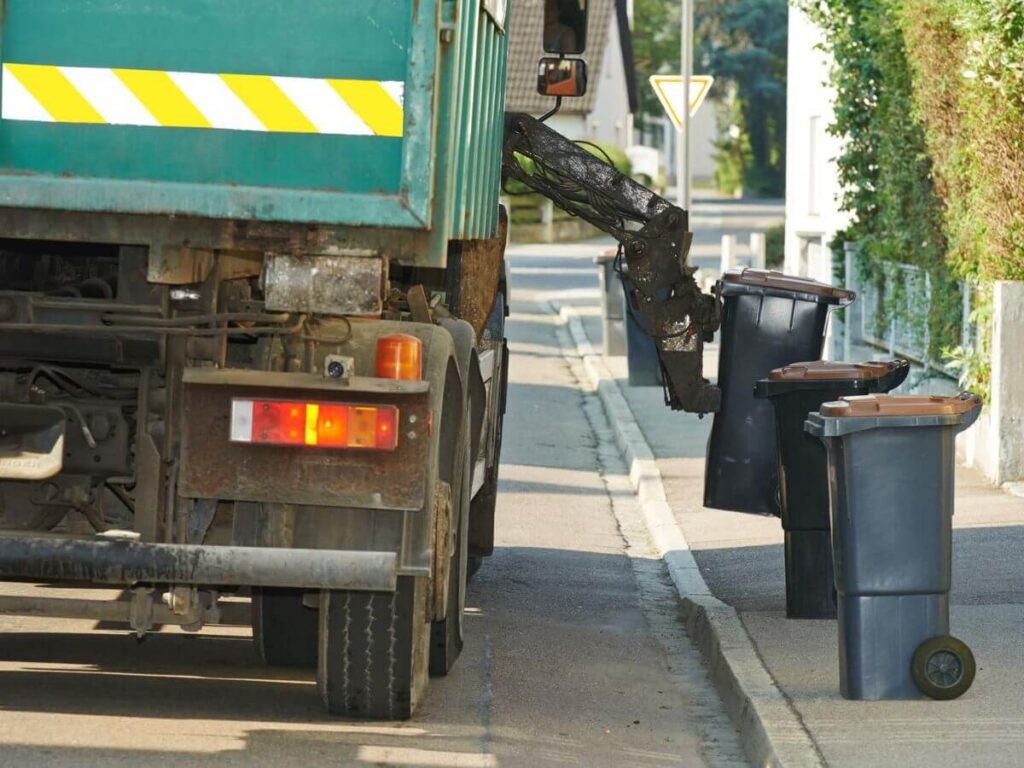
6. Common Challenges in Garbage Truck Operation
Garbage trucks work hard every day. But like any machine, they come with problems. Some are small. Others can stop a route completely. Knowing these challenges—and and how to fix them—can save time, money, and frustration.
| Challenge | What Happens | How to Solve It |
| 1. Mechanical Breakdowns | Hydraulics leak, arms jam, or compactors stop working. | Perform regular maintenance. Check fluid levels and parts before each shift. |
| 2. Overflow and Overloading | Truck fills up too fast and can’t finish its route. | Use compactors effectively. Plan routes based on waste volume. Add backup trucks. |
| 3. Traffic and Route Delays | Heavy traffic or blocked access causes missed pickups. | Use GPS tools and route-planning apps to avoid congested areas. |
| 4. Safety Hazards | Pedestrians, blind spots, and tight spaces increase risk. | Equip trucks with sensors, cameras, and backup alarms. Train drivers regularly. |
| 5. Missed Pickups | Bins are skipped or forgotten, causing complaints. | Use digital route tracking. Double-check stops before moving on. |
| 6. Fuel Waste and Idling | Trucks waste fuel sitting in traffic or on inefficient routes. | Plan routes smartly. Shut off engines during long stops. |
| 7. Bin Compatibility Issues | Some bins are too large or not compatible with the lifter. | Use adjustable lifters. Standardize bins across service areas when possible. |
| 8. Odor and Hygiene Problems | Bad smells or leakage from the truck during hot days. | Clean trucks often. Seal storage areas tightly. Use odor control sprays if needed. |
These problems show up in every part of the job. But with the right tools and habits, they can be managed. A well-maintained truck and a smart crew can keep operations running smoothly day after day.
7. Factors to Consider When Buying a Garbage Truck
Buying a garbage truck is a big decision. It’s not just about getting a machine that moves. It’s about choosing the right tool for the job—something that helps your team, fits your route, and works with your daily tasks.
Over the years, people have asked, “Which garbage truck should I buy?” And honestly, there’s no one-size-fits-all answer. It depends on what you’re hauling, where you’re hauling it, and how often you’re doing the job.
Here are five key things to think about before you make that investment.
Type of Waste
Different trucks are made to handle different types of waste. If you’re hauling construction debris, you’ll want a roll-off truck that can carry heavy loads. But if you’re dealing with household trash, a rear or side loader might work better. The truck should match the type of waste you pick up daily. That saves time and prevents damage.
Route and Location
Not every truck fits every area. Narrow city streets need smaller trucks with better turning ability. Hilly or rural routes may need stronger engines and more fuel capacity. One buyer I spoke to regretted choosing a truck that was too long for tight alleys—it sat unused. Matching the truck to the route matters more than many realize.
Loading System
Garbage trucks come with different loading styles—rear, front, or side. A rear loader often needs a helper to load by hand. A front loader is great for businesses with big dumpsters. A side loader works well in residential areas and can be run by one person. Choose a system that fits how your crew works and how your clients set out their waste.
Capacity
Truck capacity affects how many stops you can make before dumping the load. A larger truck means fewer trips to the landfill. But too much weight can wear out parts faster. It’s about balance—enough space without adding too much strain.
The trailers of garbage trucks from Rhinotrail are designed with this in mind. Whether you’re collecting municipal waste or construction debris, we let you haul more, dump less, and stay on the job longer.
Maintenance and Support
Garbage trucks take a beating. Sooner or later, they’ll need repairs. Look for brands that have local service and easy-to-find parts. If your truck breaks down and you’re waiting weeks for a part, that’s lost time—and lost business. Many buyers forget to check this until it’s too late.
Conclusion
You started this article with curiosity. Maybe a question. Maybe a story like mine—watching trucks from the sidewalk, wondering what they do.
Now you know. You’ve learned how garbage trucks work, the challenges, the benefits, and how to pick the right one.
And, if your operation depends on what happens after collection, like moving bulk waste, scrap, or materials—Rhinotrail can help you with the trailer side of the job.
We build trailers that keep your hauling efficient, steady, and safe.
Contact us today to explore trailer solutions for waste, construction, or bulk transport!


